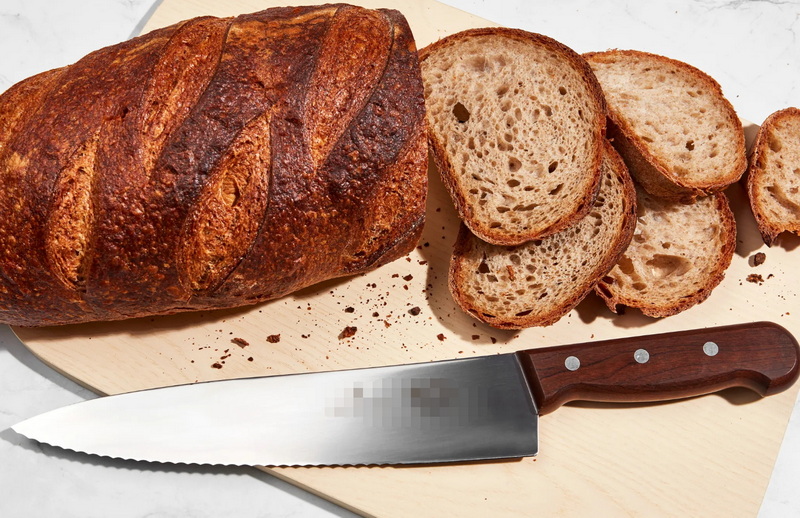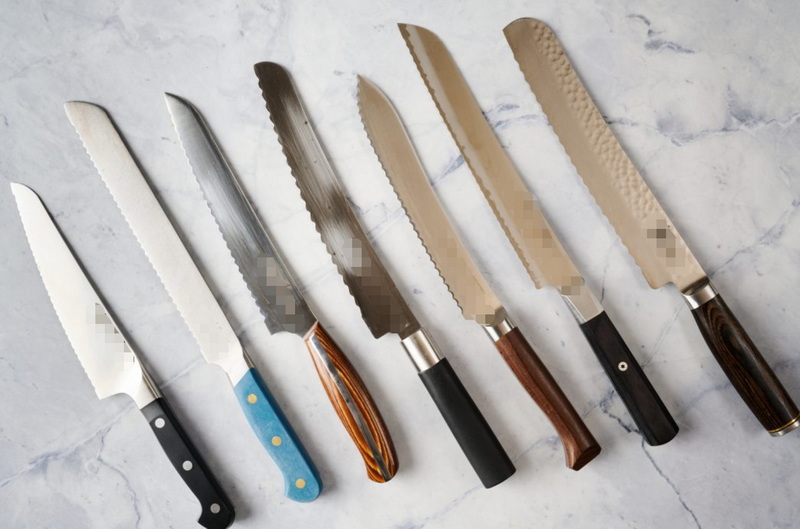- All
- Product Name
- Product Keyword
- Product Model
- Product Summary
- Product Description
- Multi Field Search
Views: 222 Author: Ann Publish Time: 2025-11-04 Origin: Site











Content Menu
● Understanding Bread Knife Performance
● Core Features That Elevate Cutting Precision
>> Blade material and heat treatment
>> Handle design and ergonomics
>> Surface finishes and coatings
● Materials, Heat Treatment, and Quality Control for OEM Partnerships
>> Steel selection and processing
>> Blade construction approaches
>> Serration manufacturing and quality
>> Quality control checkpoints
● Ergonomics and User Experience
>> Weight distribution and control
● Maintenance, Care, and Longevity
>> Market-specific preferences
>> Branding and packaging customization
>> Production lead times and MOQs
>> Bread textures and slicing techniques
● The Competitive Positioning of OEM Bread Knives
>> Differentiation through customization
>> Cost efficiency and scalability
● FAQs (Five Questions, Clear Answers)
>> 2: How should bread knives be sharpened and cared for at home?
>> 3: What is the ideal blade length for typical home loaves?
>> 4: Are forged Bread Knives worth the extra cost versus stamped blades?
>> 5: Can OEM Bread Knives be fully customized with branding, packaging, and colorways?
In a world where home bakers increasingly seek professional-grade performance from their everyday tools, the right Bread Knife makes all the difference. Our China-based kitchen knife OEM factory specializes in designing, developing, and manufacturing high-quality Bread Knives for foreign brands, wholesalers, and manufacturers. From initial concept to mass production, the emphasis remains on precise blade geometry, dependable serration patterns, ergonomic handles, and durable edge retention. With rigorous quality control, scalable minimum order quantities, and customization options that support global branding, we provide a turnkey pathway to bring premium Bread Knives to market. This article delves into the critical factors that define a superior Bread Knife, the manufacturing choices behind them, and the considerations brands must weigh when partnering with an OEM provider.

Bread Knives are specialized serrated blades designed to cut bread cleanly without tearing the crumb or crushing the crust. The interaction between blade geometry, serration profile, and edge retention determines how smoothly a loaf is sliced, how even each slice looks, and how long the blade remains sharp through frequent use. For home bakers, the right Bread Knife translates into more consistent results, less effort, and a more enjoyable baking experience. For brands partnering with an OEM manufacturer, aligning product features with target markets—North America, Europe, and Asia—drives adoption and customer satisfaction. This section outlines the core performance drivers that separate high-quality Bread Knives from average options. Bread Knife performance hinges on blade geometry, serration design, material selection, and construction quality. The blade's interaction with bread's crust and crumb is a dance of tooth geometry, hardness, and edge geometry, all orchestrated to deliver precise slices with minimal crumb damage. A well-designed Bread Knife should excel across a spectrum of bread types, from crusty artisanal loaves to tender sandwich breads, while offering a comfortable grip and reliable long-term performance.
- Typical residential options range from 8 inches to 10 inches (20 cm to 25 cm). Shorter blades offer nimble handling for smaller loaves, while longer blades span wide loaves and baguettes in a single stroke. The angle and geometry of the blade edge influence how easily crusty crusts are penetrated and how cleanly the crumb is sliced. Precision in grind and bevels supports uniform slicing across the blade's length.
- Serration shapes vary from traditional dagger-like points to more modern wave or reverse-serration patterns. The tooth count per blade length and spacing determine how aggressively the knife bites into crusts and how gentle it is on softer interiors. Dual or triple-serration designs can optimize performance for specific bread textures, while some models employ a refined “wave” serration that reduces tearing and yields cleaner slices.
- High-carbon stainless steels balance edge retention with corrosion resistance, a critical combination for regular bread cutting that may involve humid environments and bread toppings. Premium steels and carefully controlled heat treatments create a durable, sharp edge that resists dulling from crusts and seeds. Edge hardness, measured by Rockwell scales, informs how often sharpening is needed without risking chipping.
- Forged blades often offer superior balance and rigidity due to one-piece construction or laminated cores, contributing to controlled slices and reduced hand fatigue. Stamped blades can be thinner and lighter, potentially appealing for entry-level or budget offerings, but require precise tempering and geometry to maintain consistently clean cuts. Full-tang handles paired with secure rivets or scales ensure durability through heavy use.
- Ergonomics are essential for long slicing sessions. Palm-friendly contours, ample finger clearance, and a non-slip grip increase control and reduce fatigue. Materials such as pakkawood, G10, or resin composites provide branding opportunities and durable, dishwasher-safe options. Colorways and branding-friendly finishes help align the knife with partner brands' aesthetics.
- Coatings can enhance corrosion resistance and reduce adhesion of bread crumb and moisture. Non-slip textures and tactile finishes improve grip confidence in wet kitchen conditions. Branding opportunities include laser-etching or in-mold coatings that withstand washing and daily use.

- The choice of steel and the heat-treatment cycle define the knife's hardness, toughness, and edge-holding capacity. A balanced approach — achieving a stable hardness that resists dulling yet tolerates routine sharpening — supports a longer service life for home bakers and professionals alike. The production flow includes careful annealing, quenching, and tempering to ensure consistent performance across batches.
- Forged blades commonly provide higher rigidity and balanced feel, while laminated or stamped blades can offer cost efficiencies with careful process controls. Full-tang construction enhances balance and durability, particularly for daily kitchen tasks that demand reliable control.
- Serration is a precision feature; the serration profile, pitch, and edge finish must be consistent along the blade's length. Modern OEM facilities use automated or semi-automated serration tooling to achieve repeatable geometry, ensuring uniform cutting performance across every unit.
- Incoming material inspection ensures the base steel meets specified chemistry and surface quality. In-process checks include blade straightness, grind angles, serration integrity, and edge uniformity. Final testing encompasses functional slicing demonstrations on bread types, edge retention assessments after simulated use, and packaging integrity checks. Documentation supports traceability for every batch.
- The most comfortable Bread Knife suits a variety of hand sizes. A well-sized handle with a gentle taper toward the blade, adequate knuckle clearance, and a non-slip surface improves control during repetitive slicing. For brand-specific marketing, consider differentiating handles with branded textures or color accents that align with product families.
- Balanced knives reduce wrist fatigue and improve precision, particularly when slicing dense crusts or dense loaves. Weight can be tuned through blade thickness, tang design, and handle material to achieve the desired feel—striking a balance between stiffness and maneuverability.
- After use, hand-washing and thorough drying help preserve edge quality and prevent corrosion on certain steel grades. For some coatings or materials, dishwasher safety may be limited; clear guidelines should accompany each SKU in your packaging.
- Regular honing helps maintain serrated edges, while periodic professional sharpening can rejuvenate the entire edge for consistent performance. The OEM plan should include recommended maintenance intervals based on usage patterns typical of home bakers and commercial kitchens.
- Proper storage, such as blade guards or dedicated knife blocks, protects edges and prevents accidental injury. Branding opportunities abound with customized storage solutions that complement the knife's aesthetics.
- North American markets often favor longer blades with robust ergonomics, while European consumers may prioritize balance and edge retention with a preference for natural wood handles. Asian markets may appreciate compact, efficient designs that emphasize ease of care and durability. OEM providers should be prepared to adapt blade lengths, serration patterns, and handle materials to fit regional tastes and regulatory expectations.
- OEM collaborations thrive on packaging that communicates quality, safety, and usability. This includes logo placement, language localization, care instructions, and sustainability statements. Co-branding opportunities—such as branded packaging inserts, recipe cards, and care guides—enhance perceived value and loyalty.
- Transparent MOQs, scalable production lines, and clear lead times help brands plan launches and inventory. Providing options for multi-SKU families can enable tiered offerings and faster time-to-market.
- Crusty artisanal loaves require a serrated edge that can grip and cut without tearing. Sourdough and baguettes benefit from a precise, fast-saw action that preserves crumb. Softer sandwich breads demand careful, controlled slices to maintain crumb structure.
- Practical demonstrations should highlight how different blade lengths and serration patterns perform in typical home kitchens, including variable cutting boards, moisture levels, and bread shapes. A well-presented Bread Knife demonstrates consistent performance across domestic settings, reinforcing brand confidence.
- An OEM Bread Knife offers brands the ability to tailor blade geometry, serration style, handle materials, colors, and branding elements to their niche markets. This level of customization supports price differentiation and strengthens brand equity.
- Central to OEM success is the ability to deliver high-quality knives at scale, with predictable lead times and reliable supply chains. Strategic sourcing, process optimization, and streamlined QC enable competitive pricing without compromising performance.
A high-quality OEM Bread Knife from a trusted partner delivers precise blade geometry, durable materials, ergonomic handling, and reliable after-sales support. Brands benefit from rapid prototyping, scalable manufacturing, and comprehensive customization across blade, handle, packaging, and branding. If pursuing new product lines, inquire about sample development, MOQs, lead times, and collaborative timelines to ensure a smooth path from concept to consumer-ready products. By aligning engineering excellence with market-ready branding, an OEM Bread Knife program can drive differentiation in crowded markets while maintaining cost efficiency and quality consistency.

- Answer: High-carbon stainless steels are widely favored for their edge retention and corrosion resistance, balanced with ease of sharpening. For premium performance, laminated or advanced tool steels can provide superior edge stability, though they may require specialized maintenance.
- Answer: Regular honing helps maintain the serrated edge, while periodic professional sharpening restores the full edge. Hand wash and dry promptly to prevent corrosion, and store in a knife block or sheath to protect the blade.
- Answer: For standard home use, 8–9 inches (20–23 cm) covers most everyday loaves, while 10 inches (25 cm) is beneficial for larger artisanal breads and baguettes. Your selection should balance handling comfort with typical loaf dimensions.
- Answer: Forged blades usually offer better balance, rigidity, and long-term durability, which translates to more controlled slices and superior edge retention. Stamped blades can be cost-effective but require precise manufacturing controls to achieve similar performance.
- Answer: Yes. OEM partnerships commonly customize blade geometry nuances, serration style, handle materials and finishes, branding on the blade and packaging, color schemes, and value-added components like knife blocks or care sets.
The Ultimate Professional Knives for Halal Butchery in Middle Eastern Kitchens
Chef Knife Size Guide: Choosing Between 6″, 8″, 10″, And 12″
Custom Knife Handles: How To Design A Chef Knife That Fits Your Hand Perfectly
Chef Knife Surface Treatments Guide: From Polished Migaki To Damascus Patterns
Inside Our Professional Knife Sample Room: Quality You Can See
Universal Knife Block Buying Guide: Modern Acrylic & ABS Knife Holders for Professional Kitchens
Universal Knife Block: The Complete Guide To Modern, Hygienic Knife Storage
The Complete Guide To Red Handle Knife Sets: Style Meets Functionality in The Kitchen
Professional Knives for Halal Butchery And Middle Eastern Cuisine